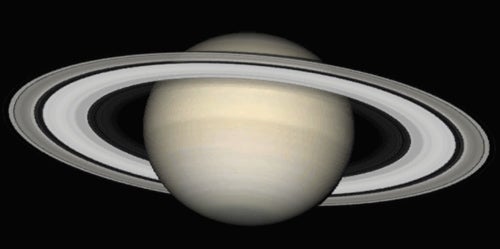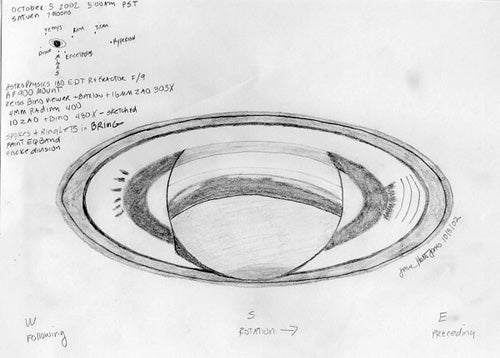Imaging Saturn
And there’s plenty amateur observers can do, says Julius Benton, Jr., who directs the Saturn Section of the Association of Lunar and Planetary Observers (ALPO). Benton says the long history of amateur and professional collaboration in astronomy continues today. “The Cassini team wants to combine ALPO Saturn Section images with data from the Hubble Space Telescope and from other professional ground-based observatories,” Benton explains.
In fact, obtaining digital images of the ringed planet during periods of good seeing is one of the most valuable contributions amateur astronomers can make. Webcams, CCD cameras, and digital and video cameras — all can provide valuable data. What will be most useful to the professional community, Benton says, are digital images of Saturn at wavelengths ranging from 400 nanometers to 1 micron (blue wavelengths to the near-infrared).
Both ALPO and the British Astronomical Association’s Saturn section encourage imaging as well as visual observation, such as intensity estimates of belts, zones, and ring components, and magnitude estimates of the planet’s satellites. Sketching is another way to capture the planet and share it with others.
No one ever forgets that first clear glimpse of Saturn. My own came in December 1974, when I was 15 and Saturn was in Gemini. Late one cold and windy night, I decided to brave the elements and make a quick assault on the ringed planet. Images in the eyepiece danced as the wind buffeted my little telescope, a 60-millimeter refractor set on a shaky tripod. Soon my eyes were watering from the New England cold.
And then suddenly there it was — a small, yellowish oval bouncing around in the field of view. In moments of relative calm, I could clearly see the tiny ball of the planet set within the oval formed from its splendid rings. The sight looked absolutely unreal, as if I were looking at a tiny Christmas ornament suspended in front of the telescope.
This is an experience all observers can share with others.
The Cassini-Huygens mission to Saturn sponsors a public outreach effort called the Saturn Observation Campaign. “This program gives sky enthusiasts of all abilities the opportunity to share the splendor of Saturn with their local community,” says Jane Houston Jones, an outreach specialist who coordinates the project at the Jet Propulsion Laboratory in Pasadena, California. “During 2005, members held 800 events reaching over 80,000 members of their communities,” she explains. Owning a telescope isn’t a necessity, but members should have access to one through an astronomy club or science center.
The campaign boasts 350 members in 44 U.S. states, as well as in 49 other countries. “We are looking for members in several states right now,” says Jones. Members participate in training sessions, receive DVDs, presentations, and handout material to help with their own outreach events. The only requirements for continued membership are to hold three events per calendar year and report these events back to the Cassini program. Primarily comprised of amateur astronomers, the members conduct star parties and provide talks to community groups about the Cassini mission. Jones says she’s now in the process of updating the project’s web page for the 2006 opposition.
This movie takes you on a decade-long tour of Saturn’s upcoming oppositions. The movie begins January 27, 2006. Saturn appears to recede and approach as Earth’s orbit carries it farther from and closer to the planet. Saturn appears largest at opposition, and the planet throws no shadow on the rings at that time. Notice how Earth passes through the plane of Saturn’s rings in 2009. Astronomy: Francis Reddy











